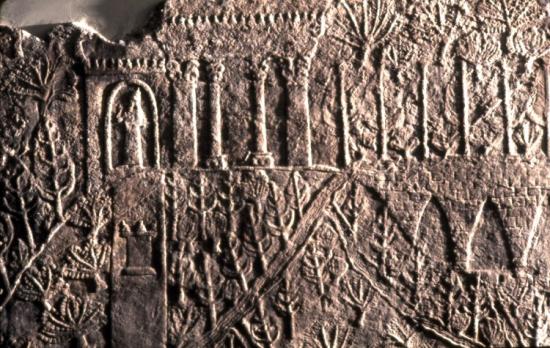PART.2
The Walajeh or ‘Ain Joweizeh Water System

The ‘Ain Joweizeh tunnels are the largest and most elegantly carved karstic water system in the region. Despite the massive effort required to carve such a tunnel, it did not draw a great deal of water. Photo courtesy Binyamin Tropper.
Daniel Ein-Mor was quick to caution me: “We don’t want to overlook the importance of a site because one aspect is attractive—the capital is attracting attention, but the water system itself is at least as interesting.” I have to agree.
We know of over 100 spring tunnels in the area, and none is even half as long as the ‘Ain Joweizeh system. It is a massive effort to cut through hard dolomite rock. The even and measured chisel marks in the Iron Age tunnel reveal that it is a masterpiece of construction, one that would have required a great deal of funding. Unlike Hezekiah’s tunnel, which carries water drawn from Jerusalem’s Gihon Spring, the Joweizeh tunnel drew its water from springs en route. The Joweizeh tunnel is the longest tunnel of its type in the region. Because of the similarity in workmanship, it is worth comparing this tunnel with Hezekiah’s, as Todd Bolen notes on the Bibleplacesblog.
Despite the extensive labor required to carve the tunnel (which includes a side channel used to regulate uneven water flow), the spring itself is relatively low flow, raising questions about its purpose. Who would have cut the hard dolomite rock and haul it hundreds of feet out of the tunnel? The tunnel does not reach Jerusalem. Where was this water going? Why was this elaborate tunnel marked by a proto-aeolic capital, a type often associated with royal construction?
Interpreting the Finds
This site has not escaped the attention of the Israeli archaeological community. Binyamin Tropper mentioned the site’s visitors, and his list included some of the most esteemed names in the field: Nadav Na’aman, Israel Finkelstein, Yuval Gadot, Amihai Mazar, Yosef Garfinkel, Norma Franklin and several others.

This Assyrian relief from the palace of Assurbanipal at Nineveh (now housed at the British Museum) shows a structure with proto-aeolic capitals atop a garden and a stream. Some believe this artistic comparison could help archaeologists understand the relationship between the water tunnel and capital.
Such a water system suggests the presence of a nearby settlement or wealthy estate (Daniel Ein-Mor specifically mentions the possibility of a royal palace or estate similar to Ramat Rahel), but so far there is no archaeological evidence of such a place. A proto-aeolic capital at ‘Ain-Sara in Jordan may be associated with a spring. Assyrian reliefs from Khorsabad and Nineveh show proto-aeolic capitals associated with gardens and springs. Following Oded Lipschits’s proposal that the capitals originated in Israel and were subsequently adopted by Assyrians before being introduced into Judah and other nearby territories, perhaps the usage shown in Assyrian reliefs would have been familiar to anyone considering constructing proto-aeolic capitals in Judah.
Of course, archaeologists have not yet uncovered anything resembling a Judahite or Assyrian-style garden estate in the area, and we can’t base assumptions about the nature of the region from a few foreign artworks. What we know now is that the construction of this water system required a great deal of labor, and someone—perhaps the Judahite government—was willing to invest a great deal in an as-yet archaeologically inconspicuous part of the hinterlands of Jerusalem.
Notes
Daniel Ein-Mor and Zvi Ron, “An Iron Age Royal Tunnel Spring in the region of Nahal Rephaim” in G. Stiebel et. al (eds.), New Studies in the Archaeology of Jerusalem and its Region (Jerusalem: Israel Antiquities Authority and Institute of Archaeology, Hebrew University of Jerusalem, 2013).
Daniel Ein-Mor, “Walajeh (‘Ain Joweizeh).” Hadashot Arkheologiyot (Online: Israel Antiquities Authority: Published 06/16/2013 http://www.hadashot-esi.org.il/report_detail_eng.aspx?id=2275)
Oded Lipschits, “The Origin and Date of the Volute Capitals from the Levant.” in: Israel Finkelstein and Nadav Na’aman, eds., The Fire Signals of Lachish: Studies in the Archaeology and History of Israel in the Late Bronze Age, Iron Age, and Persian Period in Honor of David Ussishkin. (Winona Lake: Eisenbrauns, 2011). pp. 203-225.
Norma Franklin, “From Megiddo to Tamassos and Back: Putting the ‘Proto-Ionic Capital’ in its Place.” in: Israel Finkelstein and Nadav Na’aman, eds., The Fire Signals of Lachish: Studies in the Archaeology and History of Israel in the Late Bronze Age, Iron Age, and Persian Period in Honor of David Ussishkin.(Winona Lake: Eisenbrauns, 2011). pp. 129-140.